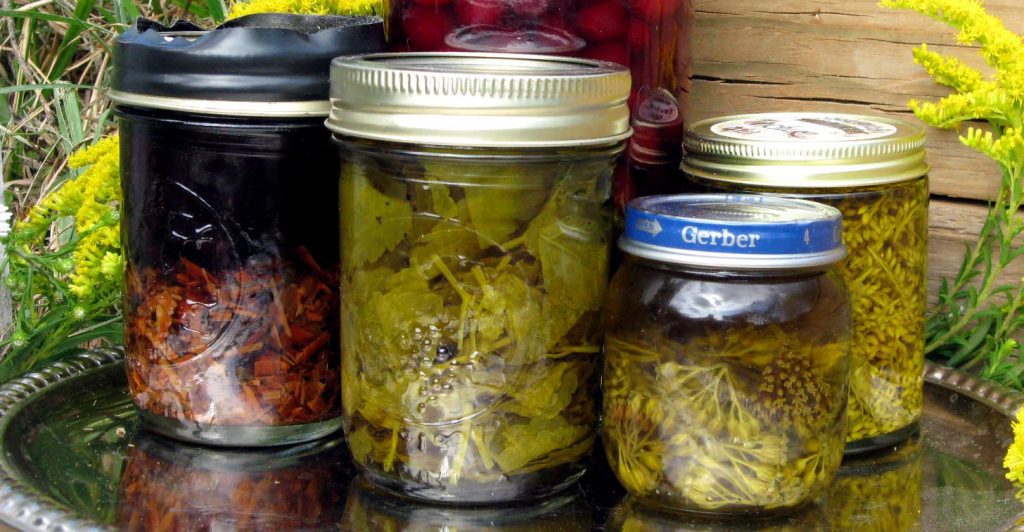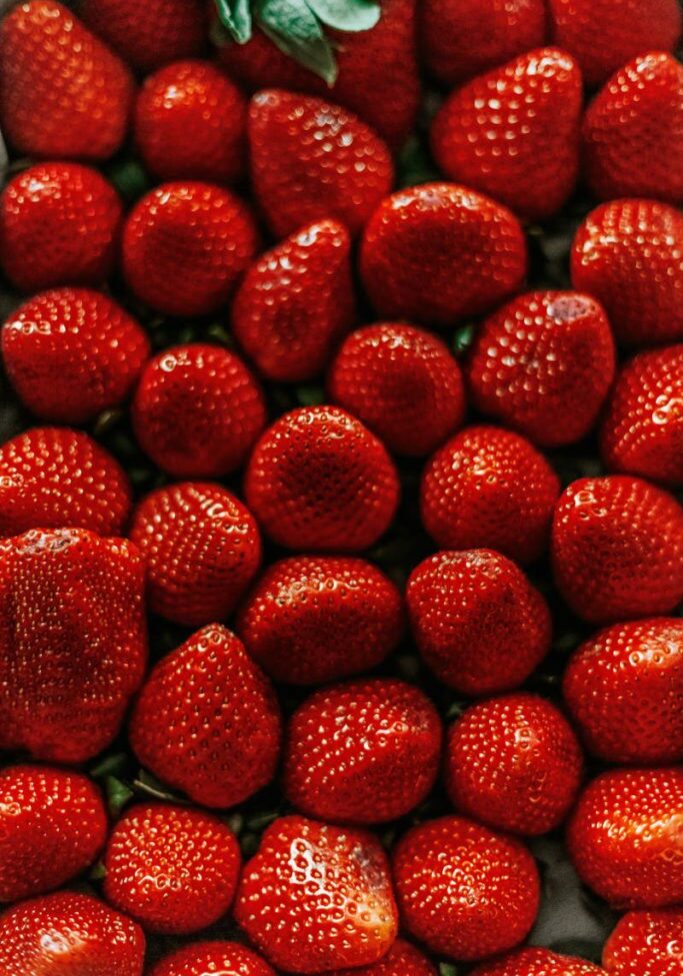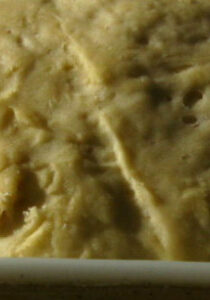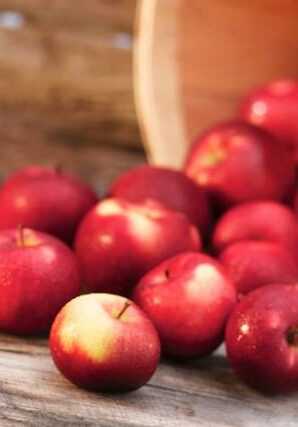"Let's Talk About" Series, Blog, Booze Recipes, Canning & Preserving, Herbal Recipes, Herbalism
Let’s Talk About Tinctures, Elixirs, and Cordials
Amber Shehan • October 6, 2011
I love herbs, and I also enjoy alcohol. My dedicated readers know for sure that I adore honey...so it shouldn't surprise you that I generally do my best to combine those three ingredients in as many forms as possible.

My apothecary is packed tight with jars and those jars are full of strange floating herbal bits in colored liquid, waiting for their time to be strained. I have many jars that are medicine, and jars that are for fun, and jars that are a bit of both.
My booze cabinet is stocked with bottles of all sizes and colors, ready for a tipple and a taste by guests. It makes me feel my most witchy to open that cabinet and bring out strange brews to share with friends. There’s a delight in enjoying last summer’s peach harvest in a delicate cordial glass while staring out at the blowing snow outside in the middle of winter!
When you start delving into recipes and techniques for making some of these projects in your own kitchen, you might notice a lot of varying terms: tinctures, elixirs, cordials and beyond! Like the folk names of plants that are attributed to different plants, herbal preparations are called by various names by different cultures. The definitions that follow are generally accepted, but your mileage may vary! I’ll point out some of the differences as we proceed through the boozy vocabulary lesson below.
Let’s start with Tinctures:
Tinctures are medicinal extracts of herbs in alcohol. Tinctures are often made with moonshine or similarly high-test liquors, but vodka, rum, and even brandy can work well. I tend to most often use a medium-shelf, triple-distilled vodka for the tinctures I craft for my household. When I have it on hand, I like to use moonshine or other high-proof booze for tincturing roots or resins.
If you are interested in learning to make tinctures that are alcohol-free, check out this article from the Herbal Academy: The Art of the Alcohol-Free Apothecary
The process for making a tincture is simple:
- Get an herb, fresh or dried.
- Put said herb into a jar – fill the jar completely with fresh herb, or half-full with dried herb.
- Pour enough alcohol into the jar to cover the herb.
- Put a lid on it, label and date it, and give it a good shake every now and again.
- Stash it in a dark cabinet for about 3-6 weeks.
- Strain the tincture into a clean jar or into tincture bottles and label clearly (date, herb, type of alcohol)
- Use as needed for many years – tinctures retain their strength best when stored out of direct light.
This is the most simple way to make a tincture, but that method can be refined once you learn more about the herbs, the ways of preparing them, and how to measure the potency of your creations. Taking an herbal course from a place like The Herbal Academy or Chestnut School of Herbal Medicine can help!
Now, tinctures are potent! When you take tinctures, please do your research before dosing yourself or find a practiced herbalist to give you guidance. Some tinctures, such as poke root or teasel, only need a couple of drops per day to be effective and more than that can cause you harm. Also, some common herbs can interact with prescription medications. It’s better to be safe than sorry!
When taking tinctures, try putting it in some water or juice to make it more palatable. If you are giving alcohol-based tinctures to children you can add it to hot tea and some of the alcohol will burn off. If you’re tough, you might be able to just handle a squirt of tincture straight into the mouth without dilution…but it’ll burn your mouth if you don’t drink straight booze often. (Whisky neat, please!)
Elixirs and Cordials are more palatable:
Elixirs are the sweetened version of alcohol-expressed medicines. I enjoy making “sipping” elixirs out of the tastier herbal tinctures. The sharp tang of elderberry cordial is a lovely flavor, but I try to save my elderberry cordial only for when I’m feeling sick. While it is tasty and sweet, it is still a strong medicine!
These can almost cross the line into cordials, which are mostly just for pleasure and flavor as far as my definitions go. The above Instagram example is made of peaches and bee balm, a delight on the tongue – but bee balm has medicinal qualities as well. I also learned from Lindy Wildsmith in her book Artisan Drinks (read my review here) that cordial often means a non-alcoholic beverage in the UK.
To use an elixir or cordial, just pour a bit into your hot tea or straight into a small glass to slowly sip and enjoy!
Elixirs can also help with the less-than-tasty herbal medicines. Remember, “just a spoonful of sugar makes the medicine go down!” Adding a sweetener to bitter or astringent herb tinctures can make ingesting them a more palatable experience, especially with kids. Valerian and Horehound are good examples of herbs that can use a splash of honey to cut their bitter strength (I use them together in my night-night cordial).
Elixirs are easy to make:
Start out with a tincture and make it sweet! You can use the simple syrup recipe below. Add the syrup to tincture a bit at a time, shake or stir to blend, and then taste. Repeat until you feel you have it right.
An important note: remember, this is medicine. Elixirs and tinctures are meant to be taken in small quantities. If you aren’t careful, this sweetening and tasting process can get you loopy!
Simple Syrup Recipe:
- Boil one cup of water.
- Add a cup of sugar (or honey, or agave, or whatever you prefer!)
- Stir until the sugar is completely dissolved.
- Let it return to a boil for one minute.
- Turn to low and let it simmer for a few more minutes.
- Allow the syrup to cool down before funneling into a clean glass bottle with a tight-fitting lid.
- Label and date your syrup and store it in the fridge.
Sometimes I use a lazier method to sweeten my tinctures. Pour a dollop of honey into a strained tincture and give it a shake until it is dissolved (or until your arm falls off). It works, but it will likely end up being super sticky and thick compared to the simple syrup sweetening process described above.
I hope that helps to demystify some of the processes and encourages you to play around in your kitchen and have another way to use your herb harvest before the final frost takes it from you!
Here are some of the cordials that I have made and shared on Pixie’s Pocket:
- Cherry Cordial
- Citrus & Rum Cordial
- Pear Cordial
- Valerian-Mint Cordial (Elixir)
- Creamy Coconut Cordial
- Blackberry Cordial & Simple Syrup
- Spiced Cranberry Cordial
- Earl Grey Cordial
- Damiana Cordial (Love Potion #9)
- Mimosa Flower & Blackberry Cordial
Watch me ramble about cordials for an entire hour!
[content-egg module=Amazon template=grid]
Get updates from Pixie's Pocket: brewing and herbs in your inbox:
Tagged: autumn, Blog, booze, brewing, cordial, cranberry, DIY projects, eat your weeds, elixir, featured, goldenrod, herbal education, herbalism, herbs, horehound, infused booze, infusion, lemon balm, let's talk about, mint, mountain rose herbs, preserving, recipe, recipe box, recipes, remedy, tincture, valerian, wildcrafting, yarrow
Amber Shehan
Hi! I'm Amber Pixie, and this is my site. Enjoy the recipes, information, posts, and please feel free to message me if you have questions!





Great post and gorgeous pictures! I have my good share of strange bottles filled with herbs as well! For your delicate-tummied love, I would suggest fennel. I suffer from bad nights too if my dinner has been too much, and a cup of fennel tea (or tincture) does wonders! If you don’t have it near, I can send you seeds from our own plant.
I just found this blog, and wow, is it ever full of great information. I have started growing all kinds of medicinal plants, but really am not sure which parts to harvest and when. Is there a resource you would suggest?
As soon as I read that you love herbs and enjoy alcohol, I wanted to become best friends! Lol! Don’t know you, but love you already!
Cheers, Felix! 🙂 Pleased to meet you!
Ooh, yes. He used to just chew a couple of fennel seeds, but now that bothers his teeth. I’ll have to try him on a tea of that, it isn’t his favorite flavor. 🙂 Mint is much more his style, and I have a non-Valerian mint elixir that he enjoys swigging that doesn’t put him to sleep!
I would be interested in doing an herb or seed exchange with you, though! We have such different climates, I bet we have much to offer each other. 😀
I like the way you two speak about this conversation (friendly.honest and last but not least growers helping eachother with genetics!!! i would never. Ever….ever….eva eva eva EVER ever ingage in ……BUT it’s legal here in the good ol’303. Lol so with that said please contact me via email @ prodicalbows@ gmail.com. I have a crossed a few amazing strains last summer an i also need your amazing strains . asap please ….contact me …..please and ththank. I am germinatinn early in early April so by 420/2017 i need medicine for my patients in tincture form. I also need a strain called charlotte’s web it’s cmd dominate strain strictly for patients needing no t.h.c and still “WORK!!” for pain ect. Ect. Ect÷
Hey dear. We weren’t talking specifically about the herb you are discussing, but herbs in general. While I am quite a fan of CBD and its healing properties, I’m not in a state that allows its legal use. I do host local herb swaps, but we stick to legal plants. I don’t have any seedlings/strains you are looking for, sorry!
Wonderful information.
I love your website, so rich in recipes and information.
Thank you Maria, that’s very kind of you!
Sharon: Thank you so much for your kind words! I can suggest a couple of books, and will totally get back to you all with a post of suggestions. Feel free to follow me, using the google follower button on the right side of the page! <3
I have a lovely garden but just recently started making my own teas and tinctures and also use herbs in spiritual practice.
This awesome blog has a wealth of information. Thank you so much!
Hey there! Sharon and Lori-Ann, I just made a new post about suggested books for your herbal reference shelf. It includes both health books and spiritual books for using herbs. Thanks for reading, and please do come back! <3
Amber
Herbal Bookshelf: http://www.pixiespocket.com/2011/10/pixies-pocket-herbal-bookshelf.html
Great post! Thanks for the herbal info. I like the info on elixir too…never made one of those but love tinctures. Thanks again! I’m a new follower too, blessings!
[email protected]
[…] add things, and make it your own! If you have never made a tincture, cordial, or elixir before, this post might be helpful to you. It is easy, I […]
[…] herbal extracts in liquid form. My friend over at Pixie’s Pocket has a great guide on how to make your own, and it’s not as hard as you would […]
[…] I haven’t tried it yet, but I assume this procedure would work with any other kinds of tea bags, from herbal to green tea to beyond. If you want to review different ways of cordial making, check out this post! […]
This page is soo great .. thank u
[…] I’ve covered before, tinctures, elixirs, and cordials are easy to make! They are a wonderful method of bringing summertime to the cold winter […]
[…] I experimented with a very intriguing recipe that we found from TheKitchn. While we’d made cordials, tinctures, and elixirs before, we had never tried doing a milk-based booze drink from […]
[…] Put them in a jar and cover them with vodka. Shake every now and then, strain in six weeks for a bittersweet lemon cordial. (More about tinctures & cordials) […]
How long do the elixirs and cordials last after the tinctures are added? I’m new to the medicinal herbal whirlwind. I have read Rosemary gladstars book and live them. Just very unsure of what I’m doing thus far as I’m just s year and s half into this. Thank you for any information
Hey there! Thanks for asking me, Lee Ann. I’ve had some cordials and tinctures that are years old. The booze does a good job of long term preservation, but there’s always a danger of fermentation or mold when there’s water and sugar added. If you open a jar and it smells like cheap wine or if it is fuzzy, don’t drink it!
One of my favorite, I guess its a tinture, I just never thought of it that way, is soaking dried ginger root in vodka for a few months. Its warm, spicy to sip neat, and it really helps w/ the bursitis pain that really acts up worse for me in the winter months. Dried cranberries soaked that way too make a nice sweet like ruby red cordial, never done it w/ fresh or frozen cranberries. The teenager confiscated all of the frozen ones for smoothies. I did a batch last year of vodka and orange zest, which is still sitting there and I’m not quite sure what to do with, since it released a nice amount of orange oil on the top. Any suggestions?
I love ginger in all forms! That sounds like an awesome method to help with the joint and muscle pain, for sure. 🙂 I have considered making cordials with dried fruit but haven’t done it yet!
I bet if you add a sugar syrup to the strained orange vodka, that it might help with blending those oils in. I’d still definitely give it a good shake before drinking!
What alternative to vodka would you recommend for someone who can’t consume alcohol?
Ah, non-alcoholic cordials can be made by a few different methods. You can make a glycerite or make cordials with just water, lemon, and berries like this lovely recipe!
You can also infuse herbs in vinegar instead of alcohol. 🙂 I hope that helps!
You can make communion wine with poke. Add to liquor and varying degrees of water and sweetener. Or use vinegar or lemon juice with varying degrees of water and a large sweetener. Color can be a deep burgundy. The vinegar poke mixture looks nice in the window. It could be the only note of color in a church. I am not sure how long the color lasts.
I’ll bet that is lovely; however, poke is strong medicine and shouldn’t be consumed often! The seeds within the berries can be very toxic to humans.
Beautiful post. Very helpful! Thank you for sharing your kitchen witchery with us.
I am concocting a cbd tincture out of a pure amber distillate and am using 180 proof alcohol. I am wanting to add spring water and honey to create a more palatable experience. Would you recommend just adding that to the finished tincture? Thank you!
Sorry for my delay in response, Linseed Fae! While I’ve used CBD tinctures, I’ve not made my own, nor sweetened them. But I can’t see why it would be a bad idea to try, both for watering down that booze and for making the whole thing easier to take. I hope it works out well for you! 🙂
I just made a nettle tincture with a bottle 192 proof grain alcohol and a bottle of 80 proof vodka. I pressed them out and am open to suggestions for making it delicious and immune boosting for a winter sipping elixir. I would like it to be shelf stable any ideas on how much fruit juice or syrup I should add so its safely preserved? I am considering maple syrup, lemon peel, or adding some kind of fruit cordial like elder flower etc… THanks! 🙂
I’m so sorry for my failure to reply! I missed this comment entirely. I hope that you were able to finish the nettle elixir. Using honey or syrup is best for long-term storage, in my experience. Anything with excess moisture, like the fruit juice or cordial, boosts the chances of spoilage. What did you end up doing? Happy New Year!
can you use stevia to sweeten the mimosa blackberry cordial?
Hi Kathy! I don’t see why not. I’m not fond of stevia myself so haven’t used it, but I’ve used honey and sugar both and know people who have used agave nectar – as long as it’s palatable to you, it’s good to go. 🙂 Enjoy!
I just made some Star Anise elixir and wondered if you could reuse the Star Anise to make another batch.
I’m making it for the suramin/shikimic Acid that will dissolve Spike Proteins (according to Dr. Judy Mikovits)
that is a result of shedding from vaccinated people. If I were to make a second batch maybe it would be less potent?
Or, is is not advised to reuse the herbs. It is recommended to take 1/4 tsp 3xdaily.
It isn’t advised to reuse herbs, as those will be weaker from the first process. Secondly, make sure you research star anise to make sure you aren’t going to hurt yourself taking that quantity over a period of time.
Vaccinated people do not shed spike proteins nor cause a threat to non-vaccinated people – in fact, it goes the other way around. That’s how vaccines work.
If you add the simple syrup to your tincture will it shorten the shelf life?